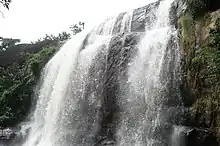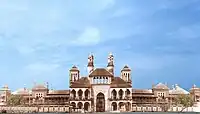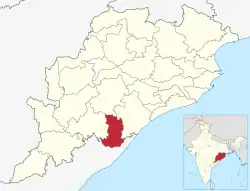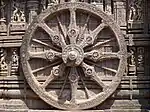Gajapati district
Gajapati district is a district of Odisha State in India. It was created from Ganjam District on 2 October, 1992. Gajapati district was named after Krushna Chandra Gajapati Narayan Deb, the King of the Paralakhemundi estate and the first Prime Minister of Orissa, who is remembered for his contribution in the formation of a separate state, and inclusion of his estate in Odisha. The district headquarters at Paralakhemundi, formerly a Zamindari, has been clustered within a radius of approximately 5 kilometers around the geometric centre of Paralakhemundi. The District is a part of the Red Corridor.[1] As of 2011 it is the third least populous district of Odisha (out of 30), after Debagarh and Boudh.[2]
Gajapati district | |
|---|---|
       Clockwise from top-left: Khasada Waterfall, Mahendragiri Hills, Padmasambhava Mahavihara monastery, Gandahati waterfall, B.N. Palace, Mahendragiri Temple, Gajapati Palace | |
 Location in Odisha | |
| Coordinates: 19.03°N 84.2°E | |
| Country | |
| State | |
| Blocks & Tahasils | 07 |
| District Formation | October 2, 1992 |
| Named for | Maharaja Krushna Chandra Gajapati Narayan Deo |
| Headquarter | Paralakhemundi |
| Block and tehsil | Paralakhemundi (Gosani) Kashinagar Gumma Rayagada Nuagada R. Udayagiri Mohana |
| Government | |
| • District Collector and District Magistrate | Smruti Ranjan Pradhan, IAS |
| Area | |
| • Total | 3,850 km2 (1,490 sq mi) |
| • Rank | 16th |
| Elevation | 850 m (2,790 ft) |
| Population (2023) | |
| • Total | 803,166 |
| • Rank | 28th |
| • Density | 209/km2 (540/sq mi) |
| Demonym | Gajapatia |
| Languages | |
| • Official | Odia, English |
| • Other Local Language | Sora • Kui |
| Time zone | UTC+5:30 (IST) |
| PIN | 761 xxx |
| Telephone code | 06815 Paralakhemundi 06816 Mohana 06817 R. Udayagiri |
| Vehicle registration | OD-20 |
| Nearest city | Berhampur |
| Sex ratio | 1042 ♂/♀ |
| Literacy | 53.49% |
| Lok Sabha Constituency | Berhampur |
| Vidhan Sabha Constituency | 2
|
| Climate | Aw (Köppen) |
| Precipitation | 1,403.3 millimetres (55.25 in) |
| Avg. summer temperature | 41 °C (106 °F) |
| Avg. winter temperature | 16 °C (61 °F) |
| Website | www |
History
The history of Gajapati district goes back to the Paralakhemundi kingdom. It was part of the Gajapati Kingdom of Odisha. During the 12th century CE Parala Khemundi was part of the Khemundi state. During the reign of Mukunda Dev Khemundi was trifurcated creating 3 states Bada Khemundi, Sana Khemundi and Paralakhemundi. After the trifurcation, Subhalinga Bhanu became the ruler of the Paralakhemundi. This line of kings continued to rule Paralakhemundi throughout the Mughal Maratha rule of Odisha. Before the British completed control of Odisha, Parala became a feudal state of British Raj during the reign of Gajapati Jagannatha Narayanadev in 1767. The state had some conflict with the British administrators. The king Gajapati Jagannatha Narayanadev and his son was arrested by the British. The state then came under direct British supervision. There was a revolt among the tribals and Paikas of the state against the King's detention. Due to this, the King was reinstated to his position. [3] Paralakhemundi remained under the administration as a feudatory state until its unification with Odisha.[4] One of the prominent kings of Parala was Krushna Chandra Gajapati. He was an active member of Utkal Sammilani and was instrumental in creating the separate state for Odisha. Finally, with the effort of Maharaja Krushna Chandra Gajapati and Utkal Sammilani, the separate state of United Odisha was formed on 1 April 1936. The state of Paralkhemundi in Vizagapatam district was partitioned into two – with the capital and most of the princely state coming under Odisha and the remaining Telugu-speaking areas remained under Madras Presidency. In 1937, the first Governor of Odisha, Sir John Austin Hubback invited Krushna Chandra Gajapati Dev to form the cabinet. Shri Gajapati was the first Prime Minister of the Odisha state from 1 April 1937 to 18 July 1937. He was the Prime Minister of Odisha for the second time from 24 November 1941 to 30 June 1944.[5][6]
It was created from Ganjam District on 2 October, 1992. Gajapati district was named after Krushna Chandra Gajapati Narayan Deb, the King of the Paralakhemundi estate and the first Prime Minister of Orissa, who is remembered for his contribution in the formation of a separate state, and inclusion of his estate in Odisha. The district headquarters at Paralakhemundi, formerly a Zamindari, has been clustered within a radius of approximately 5 kilometers around the geometric centre of Paralakhemundi.
Geography

Gajapati district located at the south-east of Odisha between longitude 84° 32'E and 83° 47'E and latitude 18° 44'N and 19° 39'N. The Mahendratanaya River flows through it. The district borders with Andhra Pradesh in the south, District of Rayagada to the west, District of Ganjam to the east and District of Kandhamala to the north. The district is located on a hilly terrain of Eastern Ghats. The mountain Mahendragiri, a segment of Eastern Ghats is situated in this district.
The climate is subtropical with high humidity. The summer season is between March and mid-June and is extremely hot with the temperature reaching 46 °C. The winter season is mild and temperature can fall lowest to 9 °C November to February. The rainy season lasts between mid-June and mid-October and it receives approximately 1000 mm of rainfall primarily from the southwest monsoons.[7]
Administrative setup
The 7 Tahasils in Gajapati district under one sub-divisions are listed in the following table.
| # | Paralakhemundi Sub-Division |
|---|---|
| 1 | Paralakhemundi |
| 2 | Gumma |
| 3 | Rayagada |
| 4 | Nuagada |
| 5 | Mohana |
| 6 | Kashinagar |
| 7 | R. Udayagiri |
The 7 Blocks in Gajapati district under one sub-divisions are listed in the following table.
| # | Paralakhemundi Sub-Division |
|---|---|
| 1 | Gosani |
| 2 | Gumma |
| 3 | Rayagada |
| 4 | Nuagada |
| 5 | Mohana |
| 6 | Kashinagar |
| 7 | R. Udayagiri |
There are 11 Police Stations under the two Police Districts in Ganjam Administrative district are listed in the following table.
| # | |
|---|---|
| 1 | Adava P.S. |
| 2 | Mohana P.S. |
| 3 | Ramagiri P.S. |
| 4 | R. Udayagiri P.S. |
| 5 | Serango P.S. |
| 6 | Kashinagar P.S. |
| 7 | Paralakhemundi P.S. |
| 8 | Gurandi P.S. |
| 9 | Garabandha P.S. |
| 10 | Rayagada P.S. |
| 11 | Energy P.S. Paralakhemundi |
Economy
In 2006 the Ministry of Panchayati Raj named Gajapati one of the country's 250 most backward districts (out of a total of 640).[8] It is one of the 19 districts in odisha currently receiving funds from the Backward Regions Grant Fund Programme (BRGF).[8]
Demographics
| Year | Pop. | ±% p.a. |
|---|---|---|
| 1901 | 184,840 | — |
| 1911 | 205,514 | +1.07% |
| 1921 | 198,842 | −0.33% |
| 1931 | 225,161 | +1.25% |
| 1941 | 252,613 | +1.16% |
| 1951 | 262,998 | +0.40% |
| 1961 | 285,069 | +0.81% |
| 1971 | 348,964 | +2.04% |
| 1981 | 402,271 | +1.43% |
| 1991 | 454,708 | +1.23% |
| 2001 | 518,837 | +1.33% |
| 2011 | 577,817 | +1.08% |
| 2023 | 803,166 | +2.78% |
| source:[9] | ||
According to the 2023 census Gajapati district has a population of 803,166,[2] approximate equal to the nation of Bhutan[11] or the US state of North Dakota.[12] This gives it a ranking of 573rd in India (out of a total of 766).[2] The district has a population density of 133 inhabitants per square kilometre (340/sq mi).[2] Its population growth rate over the decade 2001–2011 was 10.99%.[2] Gajapati has a sex ratio of 1042 females for every 1000 males,[2] and a literacy rate of 54.29%. 12.23% of the population lives in urban areas. Scheduled Castes and Scheduled Tribes make up 6.78% and 54.29% of the population respectively.[2]
Culture
The mountain Mahendragiri, a segment of Eastern Ghats is situated in Paralakhemundi. Legend says that it is the place where lord Parashurama, a Chiranjeevi staying eternally and doing tapasya. Temples built by Pandavas are seen. Main festival here is Shivaratri, the worship of Shiva, the guru or percepter of lord Parashurama.
Education
Colleges
- S. K. C. G. Autonomous College, Paralakhemundi
- Women's College, Paralakhemundi
- Sanskrit College, Paralakhemundi
- Centurion School for Rural Enterprise Management
- Centurion University of Technology and Management(CUTM)
- Gajapati College of Pharmacy
- Gajapati College of Nursing
- Gajapati School of Nursing
Schools
- Maha Raja's Boys High School (MRBHS)
- Maha Raja's Girls High School (MRGHS)
- Jawahar Navodaya Vidyalaya (JNV)
- Kendriya Vidyalaya (KV)
- Centurion Public School (CPS)
Politics
| This article is part of a series on |
| Odisha |
|---|
 |
| Governance |
|
| Topics |
|
Districts Divisions |
| GI Products |
|
|
The district sends two representatives to state legislature, Odisha Vidhan Sabha. The following is the two Vidhan sabha constituencies[14][15] of Gajapati district and the elected members[16] of those areas.
| No. | Constituency | Reservation | Extent of the Assembly Constituency (Blocks) | Member of Current Assembly | Party |
|---|---|---|---|---|---|
| 136 | Mohana | ST | Mohana, R. Udayagiri, Nuagada, Rayagada | Dasarathi Gamango | INC |
| 137 | Parlakhemundi | None | Parlakhemundi (M), Kashinagar (NAC), Guma, Kashinagar, Parlakhemundi | K. Narayan Rao | BJP |
The district is part of Berhampur (Lok Sabha constituency). The MP of Berhampur is Chandra Sekhar Sahu from the BJD.
Media
- GTV
- CHANNEL 3
References
- "83 districts under the Security Related Expenditure Scheme". IntelliBriefs. 2009-12-11. Retrieved 2011-09-17.
- "District Census Handbook 2011 – Gajapati" (PDF). Census of India. Registrar General and Census Commissioner of India.
- Dāsa, P.; Sahitya Akademi (2002). Bhakta Kavi Gopāla Krishna. Makers of Indian literature (in Latvian). Sahitya Akademi. pp. 97–99. ISBN 978-81-260-1201-5. Retrieved 2019-05-27.
- Acharya, P. (2008). National Movement and Politics in Orissa, 1920–1929. SAGE Series in Modern Indian History. SAGE Publications. p. 1. ISBN 978-81-321-0001-0. Retrieved 2019-05-27.
- Orissa Tourism Development Corporation; Odisha (India). Dept. of Home (1980). The Heritage of Odisha. Produced by Odisha Tourism Development Corporation for the Department of Home, Government of Odisha. p. 87. Retrieved 2019-05-30.
- Devi, B. (1992). Some Aspects of British Administration in Odisha, 1912–1936. Academic Foundation. p. 213. ISBN 978-81-7188-072-0. Retrieved 2019-05-30.
- "Parlakhemundi FD :: Odisha Wildlife Organisation". Welcome. Retrieved 2019-07-11.
- Ministry of Panchayati Raj (September 8, 2009). "A Note on the Backward Regions Grant Fund Programme" (PDF). National Institute of Rural Development. Archived from the original (PDF) on April 5, 2012. Retrieved September 27, 2011.
- Decadal Variation In Population Since 1901
- "Table C-01 Population by Religious Community: Odisha". Census of India, 2023. Registrar General and Census Commissioner of India.
- US Directorate of Intelligence. "Country Comparison:Population". Archived from the original on 2011-09-27. Retrieved 2011-10-01.
Solomon Islands 571,890 July 2011 est.
- "2010 Resident Population Data". U. S. Census Bureau. Archived from the original on 2011-01-01. Retrieved 2011-09-30.
Vermont 563,626
- "Table C-16 Population by Mother Tongue: Odisha". Census of India 2011. Registrar General and Census Commissioner of India.
- Assembly Constituencies and their EXtent
- Seats of Odisha
- "List of Member in Fourteenth Assembly". ws.ori.nic.in. Archived from the original on 2 May 2007. Retrieved 19 February 2013.
MEMBER NAME
